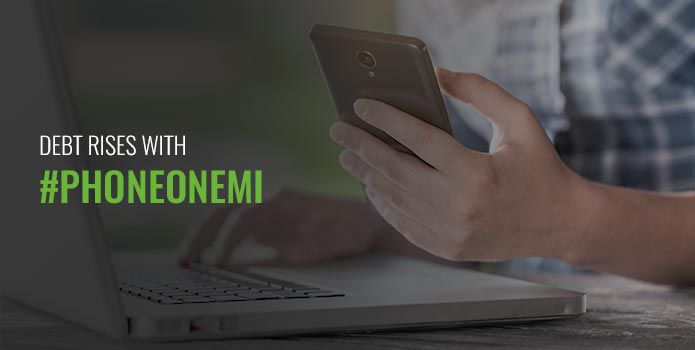The Pitfalls of Buying a Costly Cellphone on EMI

Last Updated : June 12, 2019, 10:23 a.m.
Mobile phones with high-performance features are increasingly becoming a rage amongst youngsters. The rapid technological innovations make the existing phones obsolete and urge them to buy a new one with advanced features.
But the new phones come at a high price tag, making many individuals to apply for a loan or use their credit card for the same. The loan will be paid through the EMIs, which stand for Equated Monthly Installments. Credit cards, on the other hand, have both EMI and non-EMI options by which you can purchase the phone. Looking at the steep price of phones, you may go for EMI to spread the repayment into small parts.
The EMI option, however, may not prove good to your overall financial health. The answer to why buying an expensive phone on EMI may not be good is given through the logical illustrations in this article.
Why is Buying Expensive Mobile Phones on EMI Not a Good Idea?
The reason why you should say ‘No’ to expensive phones on EMI is told below.
Depreciation Rate – Mobile phones are fixed assets that lose their value over time thanks to depreciation. The rate of depreciation on mobile phones can be around 15% every year. It means the value of phones would keep decreasing by 15% year after year. If the phone undergoes some physical scratches or its software has slowed down, you may get even lesser value by the time you sell it to someone. Let’s understand through an example below.
Example – You buy an expensive phone costing ₹1,10,000. The bank finances ₹1,00,000 for the purchase and you pay the remaining ₹10,000 plus a processing fee at about 1.50% of the loan amount + applicable GST to buy the phone. The total processing fee comes as ₹1,770 inclusive of GST. The total amount you need to pay upfront would thus equal to ₹11,770 (9,900+1,770). Assume the loan tenure and interest rate to be 2 years and 17%, respectively. In such a case, the loan repayment would pan out the way it’s shown in the table below.
| Loan Amount | ₹1,00,000 |
|---|---|
| Interest Rate | 17% |
| Tenure | 2 Years |
| EMI | ₹4,944 |
| Total Interest Outgo Over 2 Years | ₹18,661 |
| Total Loan Outgo Over 2 Years | 1,18,661 |
| Resale Value After 2 Years @15% Depreciation | ₹85,732.57 |
| Resale Value After 3 Years @15% Depreciation (Assuming you sell it after 3 years of purchase) | ₹72,872.68 |
The sale value you are expected to receive by 3 years from now would only cover 60% of the payment you make with respect to the loan. If you add another ₹11,670, which you pay from your end, to the overall loan outgo, the total outgo on phone would come as ₹1,30,431. Keeping that in mind, the resale value i.e. ₹72,872.68 in 3 years time would cover around 56% of the total cost. So, you can see your phone can come down to nearly half of the loan and cash payment you must have made to buy the device.
Buying Expensive Phones on EMI to Hurt You More on Credit Card!
The purchasing power of credit cards can sometimes lead you to buy something very expensive even though they may not be your need. So, if you buy an expensive phone on EMI, you would pay the installment in the fashion as illustrated in the table above. However, the debt burden can rise substantially if you make other purchases in addition to paying the EMI applicable to your phone. The inflated bill could force you to delay or default on the card dues.
What also adds a twist to the tale is the emergence of minimum due, which accounts for about 5% of the outstanding credit card balance. It seems payable and so you pay the same. If you maintain the routine of minimum due payment for long, the debt would pile out of proportion. It’s because the interest is levied on the massive unpaid balance on account of paying the minimum due.
The interest is levied at a higher rate of 2.50%-3.50% per month, which can accumulate to around 30%-45% in a year. The bill will also add up GST on the interest amount at every billing cycle, mounting the debt further. So, avoid expensive purchases such as mobile phones on EMI with credit cards. This will help save enough to live through the rigours of day-to-day life.
P.S. The word ‘Expensive’ is a subjective term. And so, it’s left to your discretion.